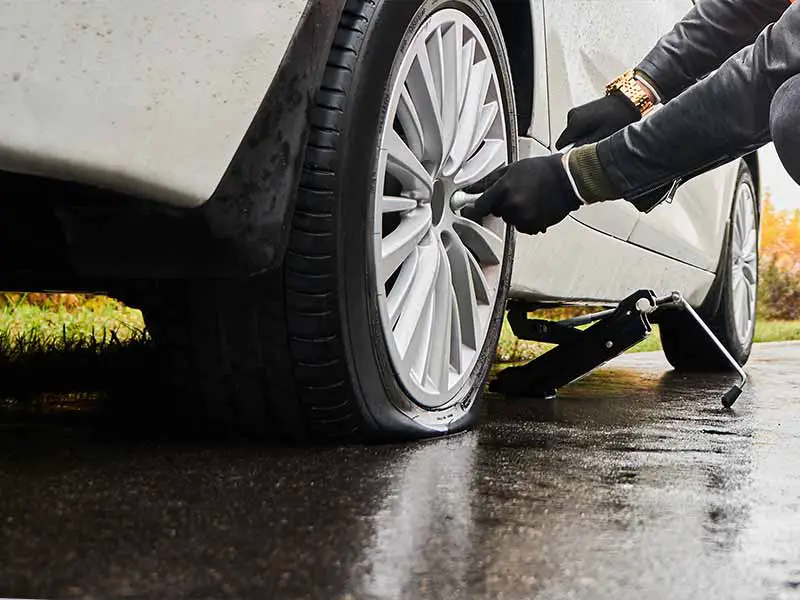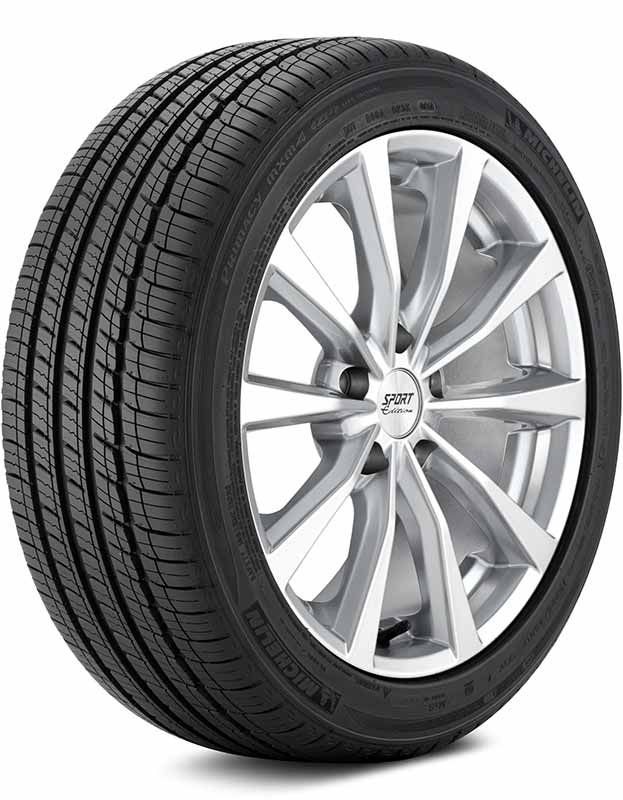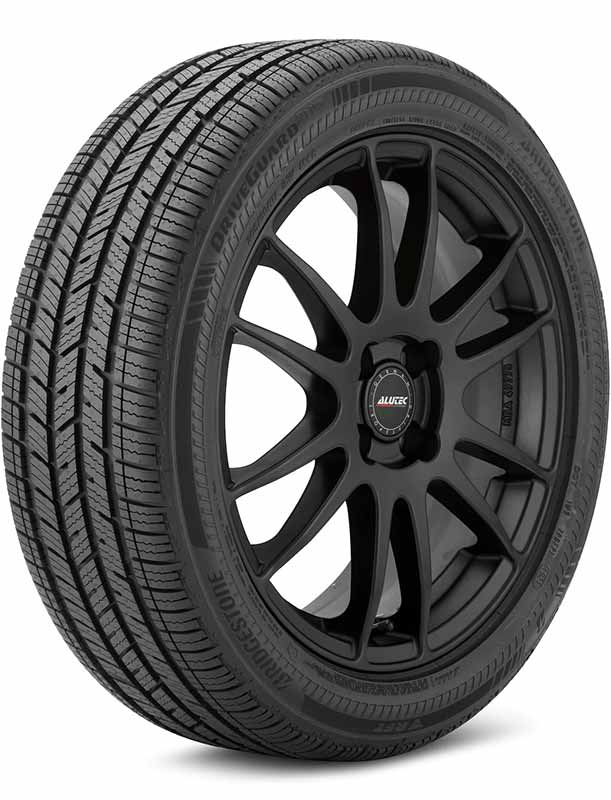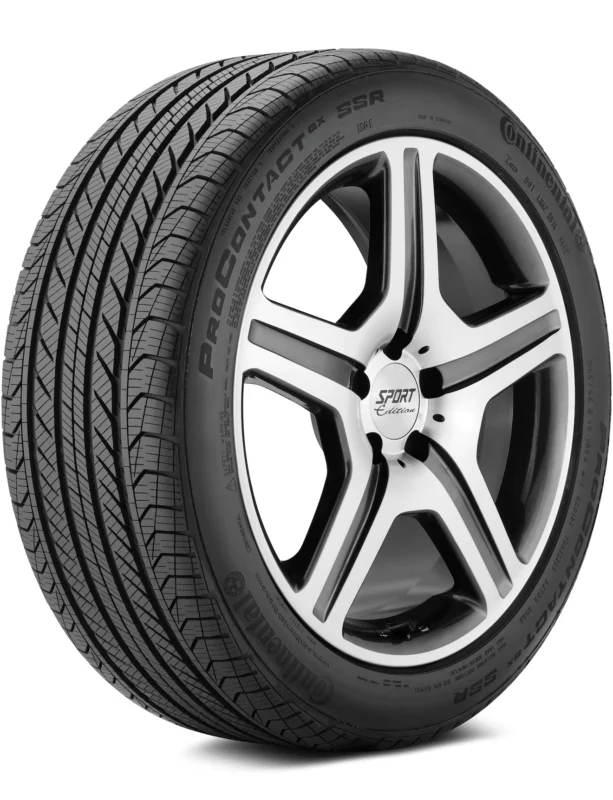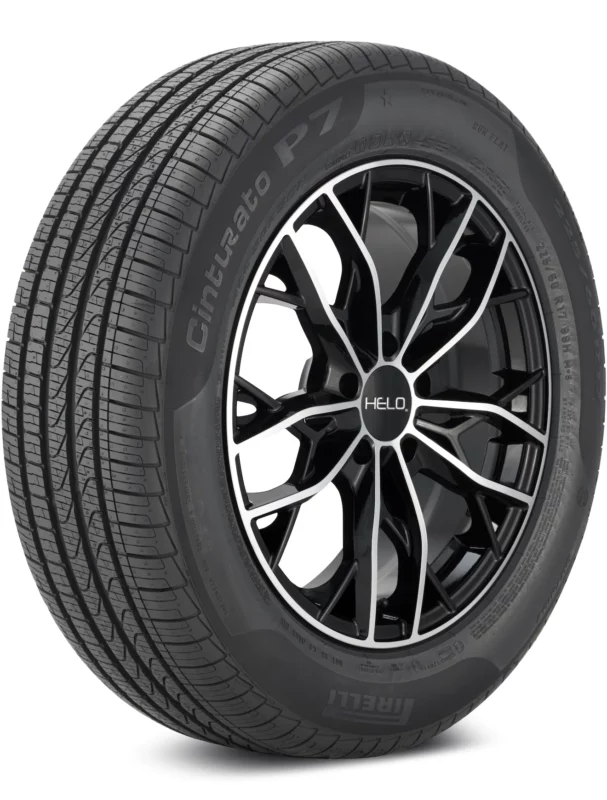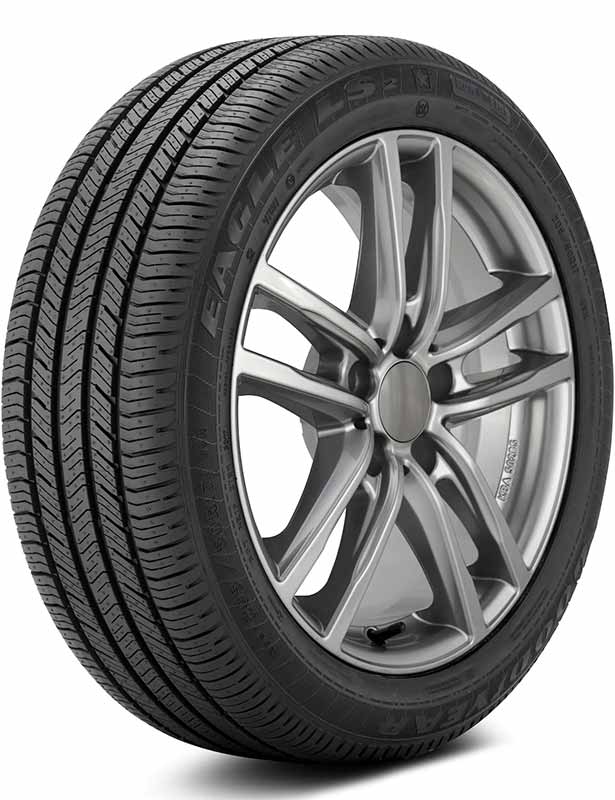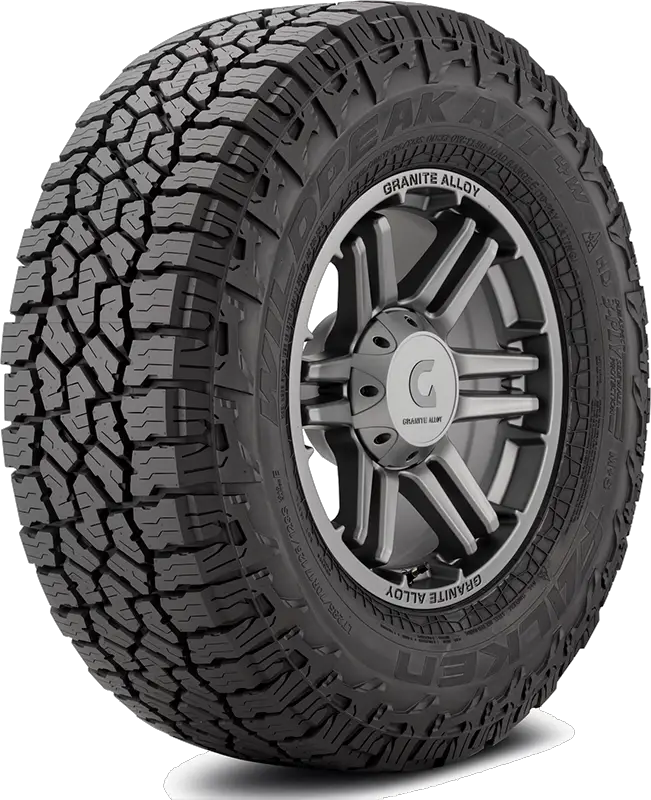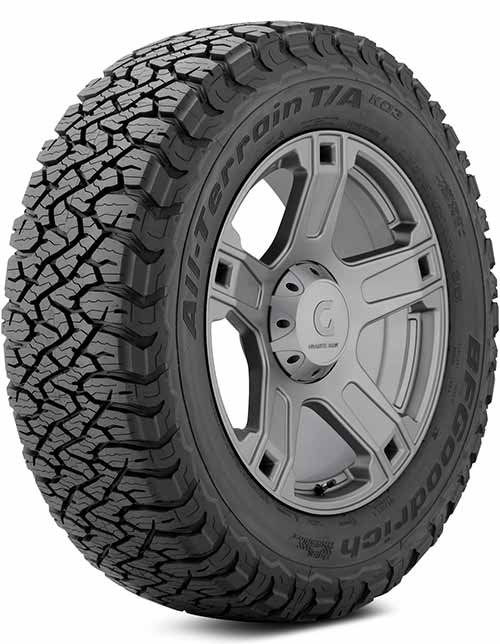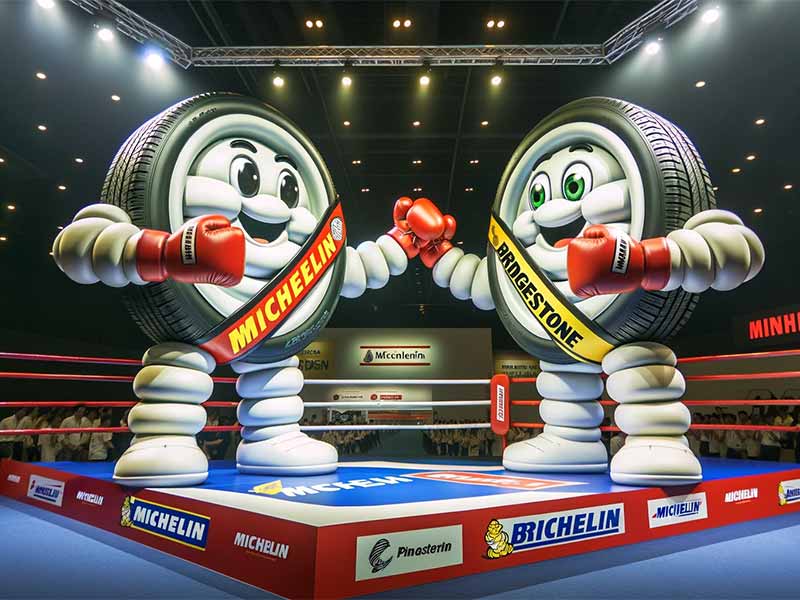Choosing run-flat tires can be daunting with so many options available. This guide simplifies the selection process, focusing on the key features that set the best run-flats apart, guiding you to make an informed choice for a safer, smoother ride.
Our top pick for the best run-flat tire is the Michelin Primacy MXM4 ZP, selected for its exceptional balance of performance, comfort, and durability. Its superior traction in both wet and dry conditions, combined with excellent tread life and a quiet, comfortable ride, makes it a standout choice for those seeking the best in run-flat tire technology.
In this article, we’ll explore the top run-flat tires on the market, delving into their features, performance, and how they stack up in terms of safety, comfort, and durability.
Best All-Season Run Flat Tires
Based on the performance statistics and calculated scores, the tires are ranked from best to worst as follows:
- Michelin Primacy MXM4 ZP with an overall score of 8.55. This tire excels across all categories, offering a balanced performance with particularly strong scores in dry conditions and comfort.
- Bridgestone DriveGuard Plus with a score of 8.32. It shines in dry conditions and steering response, with respectable scores in comfort and treadwear, making it a strong contender.
- Continental ProContact GX SSR with a score of 8.27. This tire offers consistent performance across wet and dry conditions, with a good balance in winter/snow performance and comfort.
- Pirelli Cinturato P7 All Season Run Flat with a score of 7.67. While it lags slightly behind in winter/snow performance and comfort, it offers reliable wet and dry traction.
- Goodyear Eagle LS-2 RunOnFlat with a score of 6.33. This tire has lower scores across the board, particularly in winter/snow performance and comfort, positioning it last in the ranking.
This ranking indicates that the Michelin Primacy MXM4 ZP stands out as the best option for those prioritizing a mix of performance attributes, including handling in both wet and dry conditions, comfort, and treadwear durability. The Bridgestone DriveGuard Plus and Continental ProContact GX SSR offer competitive alternatives with strong performances in specific areas.
Michelin Primacy MXM4 ZP
Customer Rating
Overall Rating
8.5 of 10
Wet Weather
8.8 of 10
Winter Weather
7.4 of 10
Tread Wear
8.5 of 10
Dry Weather
9.1 of 10
Ride Comfort
8.5 of 10
UTQG
Uniform Tire Quality Grade
UTQG Treadwear Rating: 420
UTQG Traction Rating: B
UTQG Temperature Rating: A
Mileage Warranty
6 Years / 30,000 Miles
Find The Best Price
Key Performance Metrics
Hydroplaning: 8.8 of 10
Wet Grip: 8.9 of 10
Cornering: 9.0 of 10
Dry Grip: 9.2 of 10
Responsiveness: 9.1 of 10
Mild Snow Grip: 8.0 of 10
Heavy Snow Grip: 7.2 of 10
Ice Grip: 6.9 of 10
Comfort Level: 8.5 of 10
Road Noise: 8.5 of 10
Description
The Michelin Primacy MXM4 ZP is a premium all-season run-flat tire designed for drivers who seek an exceptional blend of safety, longevity, and performance under various conditions. It stands out for its Zero Pressure (ZP) technology, allowing you to drive for a short distance at a reduced speed even after a puncture, enhancing safety and convenience. Engineered with Michelin’s advanced tread compounds and precision manufacturing techniques, the Primacy MXM4 ZP delivers outstanding traction on wet and dry surfaces, superior cornering stability, and a quiet, comfortable ride.
Review
The Michelin Primacy MXM4 ZP excels in providing a secure and responsive driving experience. Its wet and dry traction is impressive, thanks to the innovative tread design that evacuates water efficiently and grips the road with confidence. The tire’s corner stability and steering response are top-notch, allowing for precise control in various driving situations. In winter conditions, while not a dedicated snow tire, it offers reasonable performance in light snow. Ride quality and noise levels are where this tire truly shines, offering a smooth, quiet ride that enhances the comfort of any journey. Additionally, its treadwear performance suggests a longer lifespan, making it a cost-effective choice in the long run.
Pros
- Exceptional Wet and Dry Traction: Provides reliable grip and handling on wet and dry roads.
- Run-Flat Technology: Allows driving for a distance even after a puncture, enhancing safety.
- Comfortable Ride: Engineered for noise reduction and ride smoothness, ensuring a comfortable driving experience.
- Durable Treadwear: Offers longer-lasting performance, making it a cost-effective investment.
- Cornering Stability and Steering Response: Delivers precise control and responsiveness, enhancing driving confidence.
Cons
- Winter Performance: While adequate for light snow, it is not as capable in deep snow or ice compared to specialized winter tires.
- Price Point: As a premium tire, it may come at a higher price than some competitors, though the quality and longevity justify the investment.
The Michelin Primacy MXM4 ZP is a top choice for drivers prioritizing safety, performance, and comfort in an all-season run-flat tire. Its blend of advanced features and technologies makes it a standout option, albeit with considerations for winter conditions and initial cost.
Bridgestone DriveGuard Plus
Customer Rating
Overall Rating
8.2 of 10
Wet Weather
8.7 of 10
Winter Weather
6.8 of 10
Tread Wear
8.2 of 10
Dry Weather
9.2 of 10
Ride Comfort
8.1 of 10
UTQG
Uniform Tire Quality Grade
UTQG Treadwear Rating: 640
UTQG Traction Rating: A
UTQG Temperature Rating: A
Mileage Warranty
5 Years / 65,000 Miles
Find The Best Price
Key Performance Metrics
Hydroplaning: 8.7of 10
Wet Grip: 8.7 of 10
Cornering: 9.1 of 10
Dry Grip: 9.2 of 10
Responsiveness: 9.2 of 10
Mild Snow Grip: 7.4 of 10
Heavy Snow Grip: 6.5 of 10
Ice Grip: 6.3 of 10
Comfort Level: 8.3 of 10
Road Noise: 7.9 of 10
Description
The Bridgestone DriveGuard Plus is a cutting-edge all-season run-flat tire designed for drivers looking for the ultimate peace of mind on the road. It integrates Bridgestone’s latest safety innovations, allowing motorists to drive up to 50 miles at up to 50 mph after a puncture, minimizing disruptions from flat tires. Suitable for a wide range of passenger vehicles, the DriveGuard Plus features a silica-rich all-season tread compound and an optimized tread pattern that delivers excellent traction in wet, dry, and light snow conditions. This tire emphasizes safety, durability, and fuel efficiency, making it an ideal choice for daily commuting and long-distance travel alike.
Review
Bridgestone’s DriveGuard Plus stands out for its remarkable combination of safety features, performance, and comfort. The tire’s all-season capabilities are commendable, with strong performance on wet and dry surfaces and respectable handling in light snow. The run-flat technology is a standout feature, offering drivers the ability to continue their journey safely after a puncture, a significant advantage in emergency situations.
The tire’s dry handling is precise and reliable, with excellent corner stability and steering response, providing a confident driving experience. Wet traction is also a strong point, thanks to its innovative tread design that helps prevent hydroplaning. Comfort is another area where the DriveGuard Plus shines, offering a smooth and quiet ride that rivals many of its competitors.
Pros
- Advanced Run-Flat Technology: Ensures safety and convenience by allowing drivers to continue driving after a puncture.
- Excellent Wet and Dry Performance: Provides superior traction and handling in various conditions.
- Quiet and Comfortable Ride: Engineered to reduce road noise and enhance ride comfort, making it ideal for long drives.
- Durable Tread Life: Features a wear-resistant tread compound that extends the tire’s lifespan.
- Fuel Efficiency: Designed to lower rolling resistance, which can lead to improved fuel economy.
Cons
- Winter Performance: While capable in light snow, it may not perform as well in severe winter conditions compared to dedicated winter tires.
- Price: The premium features and technology of the DriveGuard Plus come at a higher cost, which might be a consideration for some buyers.
The Bridgestone DriveGuard Plus is a highly recommended option for those prioritizing safety, comfort, and all-season performance. Its run-flat capability significantly enhances driver safety and convenience, making it an excellent choice for everyday use and long-distance travel. However, those in regions with heavy snowfall might need to consider winter-specific tires for optimal performance in severe winter conditions.
Continental ProContact GX SSR
Customer Rating
Overall Rating
8.2 of 10
Wet Weather
8.7 of 10
Winter Weather
7.6 of 10
Tread Wear
7.3 of 10
Dry Weather
9.1 of 10
Ride Comfort
8.3 of 10
UTQG
Uniform Tire Quality Grade
UTQG Treadwear Rating: 500
UTQG Traction Rating: A
UTQG Temperature Rating: A
Mileage Warranty
6 Years / 65,000 Miles S & T-Rated
6 Years / 55,000 Miles H-Rated
6 Years / 45,000 Miles V-Rated
6 Years / 40,000 Miles W-Rated
Find The Best Price
Key Performance Metrics
Hydroplaning: 8.7of 10
Wet Grip: 8.8 of 10
Cornering: 9.0 of 10
Dry Grip: 9.2 of 10
Responsiveness: 9.0 of 10
Mild Snow Grip: 8.1 of 10
Heavy Snow Grip: 7.3 of 10
Ice Grip: 7.3 of 10
Comfort Level: 8.4 of 10
Road Noise: 8.1 of 10
Description
The Continental ProContact GX SSR is an innovative all-season run-flat tire designed for a wide range of passenger vehicles. Engineered with Continental’s Self-Supporting Runflat (SSR) technology, it allows drivers to continue driving for up to 50 miles at a reduced speed after a puncture or loss of air pressure, ensuring safety and convenience during unexpected situations. The tire combines an advanced silica-enhanced tread compound with an all-season tread design, offering excellent grip and handling on both wet and dry roads, as well as in light snow conditions. Its optimized tread pattern reduces road noise, making for a quieter, more comfortable ride.
Review
The Continental ProContact GX SSR excels in providing a balanced performance across various driving conditions. Its all-season capabilities ensure reliable handling and traction in wet and dry environments, and it performs admirably in light snow, making it a versatile choice for drivers in regions with mild winter conditions. The SSR technology is a standout feature, offering peace of mind by allowing drivers to maintain mobility in the event of a puncture.
This tire’s steering response and corner stability are particularly noteworthy, delivering a responsive and secure driving experience. The ride quality is another strong point, with the tire designed to absorb road irregularities effectively, contributing to a smooth and comfortable driving experience. However, its performance in deep snow and ice may not match that of specialized winter tires.
Pros
- SSR Run-Flat Technology: Provides the ability to drive on a flat tire for up to 50 miles, enhancing safety and convenience.
- Excellent Wet and Dry Traction: Ensures confident handling and braking in various conditions.
- Good Performance in Light Snow: Offers reliable traction and handling in mild winter conditions.
- Quiet and Comfortable Ride: Designed to minimize road noise and absorb vibrations for a more comfortable driving experience.
- Responsive Steering and Stability: Delivers precise steering response and stability during cornering.
Cons
- Winter Performance: While suitable for light snow, its performance in deep snow and ice is limited compared to dedicated winter tires.
- Treadwear Performance: Some drivers may find the treadwear performance less favorable compared to other premium all-season tires.
- Price: As with many run-flat tires equipped with advanced technology, the ProContact GX SSR may come at a premium price point.
Overall, the Continental ProContact GX SSR is a solid choice for drivers seeking the benefits of run-flat technology along with dependable all-season performance. It offers a great blend of safety, comfort, and handling, making it well-suited for daily commuting and long-distance travel. While it performs well in a variety of conditions, those in areas with harsh winter weather might need additional winter tires for optimal safety and performance.
Pirelli Cinturato P7 All Season Run Flat
Customer Rating
Overall Rating
7.6 of 10
Wet Weather
8.2 of 10
Winter Weather
6.5 of 10
Tread Wear
7.0 of 10
Dry Weather
8.6 of 10
Ride Comfort
7.5 of 10
UTQG
Uniform Tire Quality Grade
UTQG Treadwear Rating: 500
UTQG Traction Rating: A
UTQG Temperature Rating: A
Mileage Warranty
None
Find The Best Price
Key Performance Metrics
Hydroplaning: 8.2of 10
Wet Grip: 8.3 of 10
Cornering: 8.6 of 10
Dry Grip: 8.8 of 10
Responsiveness: 8.6 of 10
Mild Snow Grip: 7.2 of 10
Heavy Snow Grip: 6.3 of 10
Ice Grip: 6.1 of 10
Comfort Level: 7.6 of 10
Road Noise: 7.4 of 10
Description
The Pirelli Cinturato P7 All Season Run Flat is a high-performance tire designed for drivers of sedans, coupes, and crossovers who demand safety, efficiency, and reliability throughout the year. Incorporating Pirelli’s cutting-edge run-flat technology, this tire allows you to continue driving for a certain distance after a puncture, ensuring that you’re not left stranded. The Cinturato P7 is crafted with a special silica and polymer compound that enhances grip in both wet and dry conditions while also providing a lower rolling resistance for improved fuel economy. Its unique tread pattern is optimized for noise reduction, providing a quiet and comfortable ride.
Review
The Pirelli Cinturato P7 All Season Run Flat stands out for its blend of eco-friendly performance, safety features, and all-season reliability. Its ability to maintain performance after a puncture is a significant benefit for any driver, offering peace of mind during travel. On wet and dry surfaces, the tire demonstrates excellent traction and braking capabilities, attributed to its innovative tread compound and design.
While it provides dependable handling and stability, its performance in light snow is adequate, making it suitable for regions with mild winter conditions. The Cinturato P7 is also designed with comfort in mind, ensuring a quieter ride compared to many competitors. However, it’s worth noting that its performance in deep snow and ice, like many all-season tires, does not match that of specialized winter tires.
Pros
- Run-Flat Technology: Offers the ability to continue driving for a limited distance after a puncture, greatly enhancing safety.
- Eco-Friendly Performance: Engineered to reduce fuel consumption and CO2 emissions through its low rolling resistance.
- Excellent Wet and Dry Grip: Provides superior traction and braking in various conditions thanks to its advanced compound.
- Quiet and Comfortable Ride: Features a tread design optimized for reducing road noise and enhancing ride comfort.
- Good Handling and Stability: Delivers responsive steering and stable cornering performance.
Cons
- Limited Winter Performance: While capable in light snow, its performance in harsh winter conditions is moderate.
- Treadwear: Some users may find the tread life shorter compared to other premium all-season tires.
- Cost: As with many run-flat tires, the initial investment might be higher, although the safety and performance benefits can justify the cost.
In summary, the Pirelli Cinturato P7 All Season Run Flat is a well-rounded tire offering a strong balance between safety, efficiency, and all-season performance. It’s an excellent choice for drivers looking for a tire that combines the convenience of run-flat technology with eco-friendly features and a comfortable ride. While it excels in many areas, those in regions with severe winter weather might need to consider additional options for optimal traction and safety.
Goodyear Eagle LS-2 RunOnFlat
Customer Rating
Overall Rating
6.2 of 10
Wet Weather
6.8 of 10
Winter Weather
4.9 of 10
Tread Wear
6.0 of 10
Dry Weather
7.4 of 10
Ride Comfort
5.9 of 10
UTQG
Uniform Tire Quality Grade
UTQG Treadwear Rating: 400
UTQG Traction Rating: A
UTQG Temperature Rating: A
Mileage Warranty
None
Find The Best Price
Key Performance Metrics
Hydroplaning: 6.8of 10
Wet Grip: 6.8 of 10
Cornering: 7.3 of 10
Dry Grip: 7.7 of 10
Responsiveness: 7.2 of 10
Mild Snow Grip: 5.7 of 10
Heavy Snow Grip: 4.7 of 10
Ice Grip: 4.3 of 10
Comfort Level: 5.8 of 10
Road Noise: 5.9 of 10
Description
The Goodyear Eagle LS-2 RunOnFlat is a luxury all-season run-flat tire designed for sedans, minivans, and crossover vehicles. It emphasizes comfort, quietness, and all-season traction, with the added security of Goodyear’s RunOnFlat technology, allowing drivers to continue driving up to 50 miles at up to 50 mph after a puncture or loss of air pressure. The tire features a symmetric tread design with wide circumferential grooves for enhanced wet traction and a special tread block sequence for reduced road noise. The premium sidewall construction and innovative materials offer a smooth ride and durability.
Review
The Goodyear Eagle LS-2 RunOnFlat is tailored for drivers who prioritize safety and convenience without compromising on comfort and quietness. Its run-flat capability is particularly appealing for those who want the assurance of being able to drive to safety in the event of a flat tire. On wet and dry surfaces, the tire provides satisfactory performance, thanks to its efficient water evacuation and grip-enhancing tread design.
However, its performance in winter conditions, particularly on ice and in deep snow, is somewhat limited, making it more suitable for areas with mild winters. The tire’s ride quality is a strong point, with a focus on reducing vibrations and noise for a more comfortable driving experience. While it offers a range of benefits, potential buyers should consider their specific needs, especially regarding winter driving.
Pros
- Run-Flat Technology: Enables driving for a distance after a puncture, offering peace of mind and enhanced safety.
- Comfort and Quietness: Designed for a smooth ride and to minimize road noise, improving overall driving comfort.
- All-Season Performance: Offers reliable traction in wet and dry conditions, suitable for a variety of driving environments.
- Durability: Built with high-quality materials and construction techniques for long-lasting performance.
Cons
- Winter Performance: Limited capabilities in snow and ice compared to dedicated winter tires or other all-season tires with stronger winter performance.
- Handling: Some drivers may find the tire’s handling and responsiveness less sporty compared to other models in its category.
- Treadwear: Feedback on tread life has been mixed, with some users experiencing shorter than expected tire longevity.
The Goodyear Eagle LS-2 RunOnFlat is a solid choice for those seeking the convenience of run-flat technology paired with a focus on comfort and quietness for all-season driving. Its performance in mild to moderate weather conditions meets the needs of most drivers, although those in regions with severe winter weather should consider its limitations in snow and ice. Balancing its features and potential drawbacks will help determine if it’s the right tire for your driving needs and preferences.
Types Of Run Flat Tires
As run-flat tires have evolved, the methods of dealing with punctured tires and maintaining tire pressure have as well.
Let’s briefly review the different types of run-flat tires and explain the pros and cons of each type.
Self-Sealing
The simplest and arguably best run-flat tires are the self-sealing run flat. Self-sealing tires have a lot of benefits, but they aren’t a perfect solution for everyone.
Self-sealing run-flat tires perform like conventional tires in almost every way. They are constructed essentially the same as traditional radial tires with the exception of the addition of an extra layer built into the inner layer of the tire that will seal around an object that punctures the tire.
They will also seal a hole left by an object that is pulled out of a tire that is as large as 3/16″. Tires with punctures much larger than this can not be repaired whether they are run flats or not.
The self-sealing materials used in these tires form a permanent patch in the puncture automatically and require no repair. They will also not lose any meaningful amount of air pressure when punctured. The seal forms almost instantly.
Usually, the driver will not even be aware that there has been a puncture. They will continue driving blissfully unaware there was ever an incident. The patch will continue to hold and no action needs to be taken by the owner.
If there is a foreign object still embedded in the tire, like a screw or nail, it can safely be removed and the tire will seal back around the puncture immediately.
The one downside to this type of run-flat tire is that it is unable to deal with larger punctures. Anything large than 3/16″ will not be able to properly seal the hole and will still leave you stranded on the side of the road.
Pros
- Automatically seals punctures up to 3/16″
- Tire construction is identical to conventional radial tires and performs the same
Cons
- Can’t run flat with zero pressure
- Will fail to seal punctures larger than 3/16″ and fail, leaving you stranded
Self-Supporting
Self-supporting run-flat tires are what most people think of when they think of a run-flat tire. These are tires that have stiffer sidewalls that are reinforced to allow the tire to support the weight of the car or truck without the help of air pressure.
These tires are capable of being driven on without air in them for up to 50 miles at a speed no greater than 50 miles per hour. This means that when your tire pressure monitoring system (TPMS) detects a significant drop in pressure, you will need to immediately find a safe place where you can then deal with the problem.
You will need to pay close attention to the TPMS indicator since run-flat tires can be difficult to “feel” when flat tires occur. You will want to check the individual pressures of each tire to determine if the tire is simply low or completely flat. This is especially true if you’re driving at highway speeds.
Not all TPMS systems are capable of detecting the actual tire pressure and may only be able to alert you to a pressure inconsistency in one of the tires. If this is your situation, you will need to pay special attention to this warning and check the pressures of your tires manually every time this type of TPMS warns you of a problem.
Self-supporting run-flat tires are known for their harsh ride quality due to their very stiff sidewall design. This can be quite uncomfortable, especially with low-profile tires and vehicles with stiffer suspensions.
It should also be noted that a conventional tire or self-sealing run flat will be lighter than heavier run-flat tires with self-supporting sidewalls.
Pros
- Can run-flat with zero pressure
- Can provide 50 miles of range at up to 50 miles per hour
Cons
- Harsh ride quality
- Heavier than a conventional tire or self-sealing run-flat tires
Auxiliary-Supported
Auxiliary-supported run-flat tires are similar to having a tire within a tire. Inside the tire is a support ring that is mounted to the wheel. It is structurally supportive and allows you to continue driving until you can reach a safe location.
It works a lot like self-supporting run-flat tires with the exception that you won’t have the harsh ride quality associated with the stiffer sidewall.
Unfortunately, auxiliary-supported tires have a few significant downsides that have prevented their acceptance in the marketplace. Expense is the largest issue. They require a specially-designed wheel to allow the mounting of the inner support ring. They also have never achieved significant volume production to allow replacement costs to come down.
Michelin had an auxiliary-supported run-flat design known as PAX which they have discontinued due to vehicle manufacturers not being willing to back the design and help Michelin bring it into mainstream acceptance.
Pros
- A run-flat design that eliminates the harsh ride quality of traditional self-supporting sidewall run flats
Cons
- Expensive
- Requires a unique wheel designed to support this system
- Not widely available
Tires generally fall into one of three main categories – All-Season, Summer, and Winter.
Within these are typically performance or touring tires. Performance tires prioritize traction in dry and wet conditions but tend to have shorter life spans. Grand touring tires prioritize comfort and noise in exchange for extreme performance.
It’s important to distinguish between the type of tire design and as well as the type of run-flat design to understand which one will be best for you and your needs.
Review Process
It’s nearly impossible to collect every available tire on the market and measure their performance under the exact same conditions. UTQG attempts to do this but it’s an old methodology and needs updating, but it still provides some valuable insight.
A better metric for measuring tire performance is a large sample of customer feedback specifically answering questions about individual performance characteristics.
With a large enough pool of customer comments and grades, a reasonably accurate ranking can be made for how well you will find a tire to work for you in a given situation.
Third-party customer feedback is compiled and averaged across multiple performance metrics and averaged to provide an overall score and each tire is ranked based on these criteria.
Customer feedback is broken down into the following:
- Wet Traction
- Dry Traction
- Comfort
- Treadwear
In this case, the tires were also ranked specifically on customer feedback regarding snow performance.
Unfortunately, not every tire has the sales volume to collect a sizable enough database of feedback from real-world customers. This means you won’t find lesser-known brands and shorter-run models in our reviews.
However, when manufacturers that may not be household names hit a home run, the tire will become popular and eventually rise to the attention of enough customers that enough data will be collected to allow for a reasonable ranking of it versus the competition.
Over time this article will be updated and as new designs come to the market that pushes the performance envelope further and set a new bar, you’ll find them here.
Resources
Below are some links you may find helpful when learning about tires
- What are run flat tires? – Tire Rack
- Self sealing tires: A marketing spin or do they really work? – TiresVote.com
Final Thoughts
Run-flat tires offer the convenience of avoiding immediate tire changes after a puncture, potentially increasing safety in certain situations. However, some drivers might find the trade-offs, such as a harsher ride and higher replacement costs, not worth the benefits. Whether run-flats are right for you might depend on your driving habits, the distances you typically travel, and your proximity to repair facilities.
However, it’s essential to weigh the trade-offs, such as cost and ride quality, against the unparalleled convenience and safety benefits run-flat tires provide. Remember to consider factors like treadwear warranties, seasonal performance, and noise levels to find the best fit for your driving experience.
While our top pick is the Michelin Primacy MXM4 ZP, all of the tires on this list are capable performers and solid picks.
Good luck and happy motoring.
